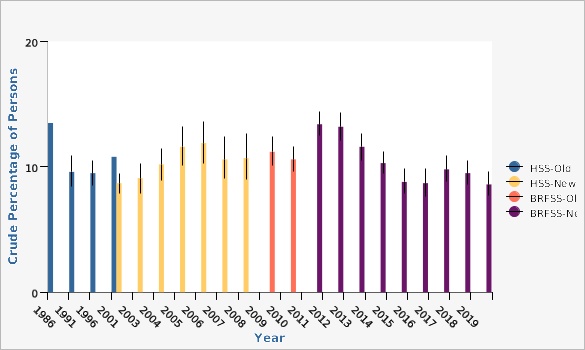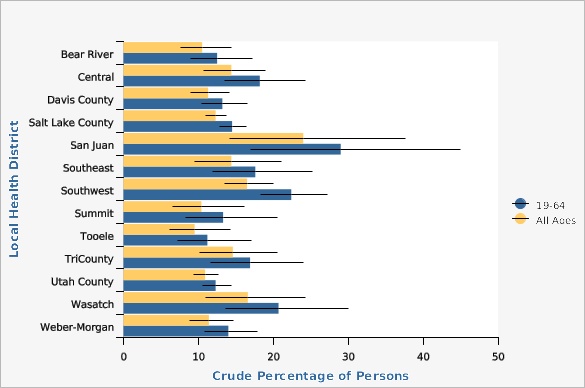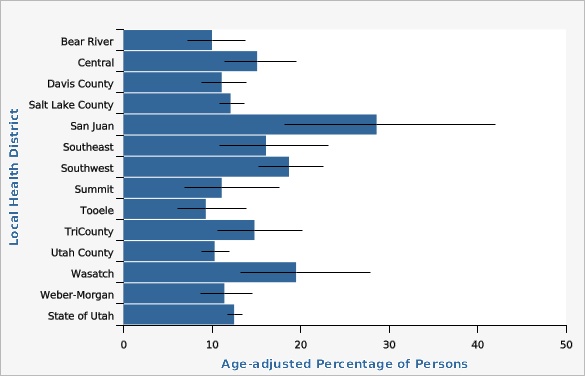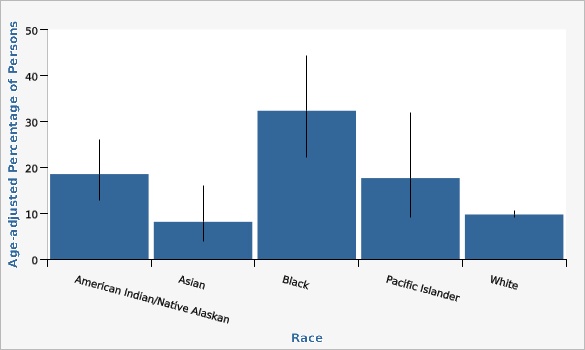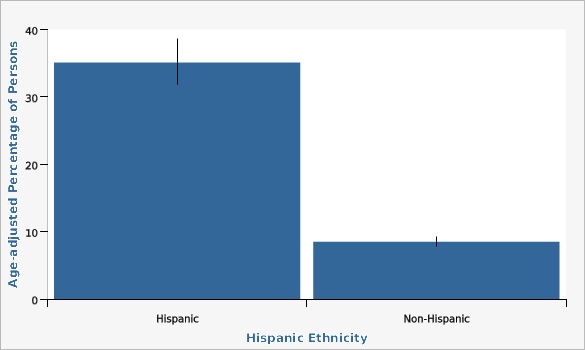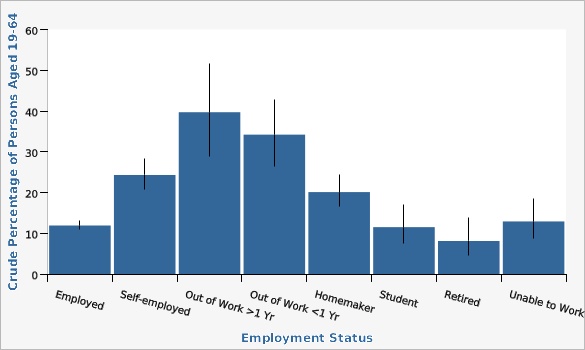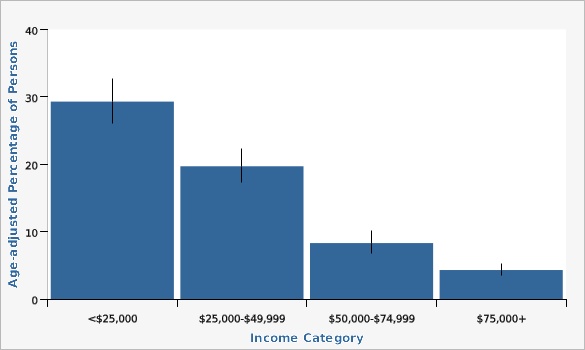Complete Health Indicator Report of Health Insurance Coverage
Definition
The percentage of persons without health insurance coverageNumerator
Number of persons in the survey sample who lacked health insurance coverageDenominator
Total number of persons in the survey sampleData Interpretation Issues
Estimates of the uninsured in Utah are currently calculated using a set of state-added questions included on the Utah Behavioral Risk Factor Surveillance System (BRFSS). Formerly these questions were asked on two state-based surveys - the Utah Healthcare Access Survey (UHAS) and the Utah Health Status Survey (HSS). Since 2011 the BRFSS has included both landline and cell phone telephone interviews as well as an updated weighting methodology. For more information, please see: [https://ibis.health.utah.gov/pdf/opha/resource/brfss/RakingImpact2011.pdf]. Compared with state surveys in Utah, the U.S. Current Population Survey (CPS) and the American Community Survey (ACS) have historically yielded higher estimates of the Utah population with no health insurance coverage. Reasons may include differences in question-wording, data weighting, and data imputation for missing values. For a thorough discussion of why state health insurance estimates differ from those produced by the U.S. Census Bureau, please refer to the State Health Access Data Assistance Center (SHADAC) publication 'Comparing Federal Government Surveys that Count the Uninsured: 2016' at [http://www.shadac.org/publications/comparing-federal-government-surveys-count-uninsured-2016].Why Is This Important?
Most people need medical care at some time in their lives. Medical care is often quite expensive and is becoming more expensive. Health insurance covers all or some costs of care and protects people from very high expenses. Persons with health insurance are more likely than persons without health insurance to have a regular source of primary health care and to have routine preventive care. Persons without coverage often have delayed seeking needed care and find services difficult to afford.Healthy People Objective AHS-1.1:
Increase the proportion of persons with medical insuranceU.S. Target: 100 percent
How Are We Doing?
In 2020, an estimated 383,500 (11.8%) of Utahns were without health insurance coverage. (BRFSS data)How Do We Compare With the U.S.?
In 2020, the ACS estimate for uninsured Utahns was 9.7%* while the national ACS estimate was 9.2%*. At 11.8% in 2020, the Utah BRFSS data was less than the ACS Utah uninsured rate. The slight variation of the estimate of the uninsured from the BRFSS are because the questions used to estimate insurance coverage are considered 'state-added' questions and are specific to Utah. *2020 ACS figures are yet to be released.What Is Being Done?
The Utah Department of Health administers programs to improve access to care, such as Medicaid, Children's Health Insurance Program (CHIP), and Utah's Premium Partnership for Health Insurance (UPP). The Department also works to improve the "safety net" for persons who lack health insurance. This is done through primary care grants to rural areas and clinics for children with disabilities. Local health departments provide preventive services such as immunizations and screenings at low or no cost to eligible persons who cannot afford them.Available Services
MEDICAID: In the Salt Lake City area, call (801) 538-6155.[[br]] In Utah, Idaho, Wyoming, Colorado, New Mexico, Arizona, and Nevada, call toll-free (800) 662-9651.[[br]] From other states, call (801) 538-6155.[[br]] Medicaid Customer Service staff are available to take inquiries. CHIP: Children's Health Insurance Program (for children 0-18)[[br]] Call (877) KIDS-NOW (543-7669) [[br]]or visit the CHIP website at [http://chip.health.utah.gov/] UPP: Utah's Premium Partnership for Health Insurance[[br]] (888) 222-2542 or visit [http://medicaid.utah.gov/upp/]Health Program Information
Concerns about rising health care costs and the affordability of health care insurance led to the enactment of the Patient Protection and Affordable Care Act (ACA) in 2010. In Utah, citizens can sign up for health insurance through the federal exchange or through the Utah exchange, Avenue H, if they work for a participating small business.Related Indicators
Relevant Population Characteristics
Age, income, and poverty level may affect a person's ability to obtain health insurance.Related Relevant Population Characteristics Indicators:
Health Care System Factors
Health insurance coverage is an important part of the health care system. Persons without coverage find it difficult to afford health care, and often delay or fail to obtain necessary care. Dental and mental health care are especially fragile elements of health care coverage. Health plan "report cards" are constructed for managed care plans by the UDOH Office of Health Care Statistics, using information collected from surveys of persons who had those health insurance plans. Persons who lack coverage are more likely to be hospitalized for ambulatory care sensitive conditions (those conditions most effectively treated in outpatient settings). The Utah Department of Health manages Medicaid, Children's Health Insurance Program (CHIP), the Primary Care Network (PCN), and Utah's Premium Partnership for Health Insurance, all of which are designed to provide coverage or pay for services for persons who lack private health insurance coverage.Related Health Care System Factors Indicators:
- Managed Care (CAHPS) Survey: Patient Rating of Experience with Getting Needed Care
- Managed Care (CAHPS) Survey: Experience with Customer Service
- Managed Care (CAHPS) Survey: Patient Ratings of Health Plan Experience
- Managed Care (CAHPS) Survey: Patient Rating of Health Care Experience
- Cost as a Barrier to Health Care
- HEDIS (Healthcare Effectiveness Data and Information Set) Measures: Diabetes Care - Hemoglobin A1c (A1C)
- Uninsured Children
- Medical Assistance Expenditures
- Medicaid Inflation
- Personal Doctor or Health Care Provider
- Routine Dental Health Care Visits
- Routine Medical Care Visits
Risk Factors
There is an association between poverty and lack of insurance.Related Risk Factors Indicators:
Graphical Data Views
Compared with state surveys in Utah, the U.S. Current Population Survey (CPS) and the American Community Survey (ACS) have historically yielded higher estimates of the Utah population with no health insurance coverage. Reasons may include difference in question wording, data weighting, and data imputation for missing values. For a thorough discussion of why state health insurance estimates differ from those produced by the U.S. Census Bureau, please refer to the State Health Access Data Assistance Center (SHADAC) publication 'Comparing Federal Government Surveys that Count the Uninsured: 2016' at [http://www.shadac.org/publications/comparing-federal-government-surveys-count-uninsured-2016].
Beginning in 2011, BRFSS data include both landline and cell phone telephone users as well as an updated weighting methodology for analysis. BRFSS data shown in this graph are based on the old methodology for years 2009 and 2010 and the new methodology for years 2011 forward.
| U.S. ACS, Utah ACS, Utah BRFSS | Year | Crude Percentage of Persons | Lower Limit | Upper Limit | ||
|---|---|---|---|---|---|---|
Record Count: 35 | ||||||
| U.S. ACS | 2008 | 15.1% | 15.0% | 15.2% | ||
| U.S. ACS | 2009 | 15.1% | 15.0% | 15.2% | ||
| U.S. ACS | 2010 | 15.5% | 15.4% | 15.6% | ||
| U.S. ACS | 2011 | 15.1% | 15.0% | 15.2% | ||
| U.S. ACS | 2012 | 14.8% | 14.7% | 14.9% | ||
| U.S. ACS | 2013 | 14.5% | 14.4% | 14.6% | ||
| U.S. ACS | 2014 | 11.7% | 11.6% | 11.8% | ||
| U.S. ACS | 2015 | 9.4% | 9.3% | 9.5% | ||
| U.S. ACS | 2016 | 8.6% | 8.5% | 8.7% | ||
| U.S. ACS | 2017 | 8.7% | 8.6% | 8.8% | ||
| U.S. ACS | 2018 | 8.9% | 8.8% | 9.0% | ||
| U.S. ACS | 2019 | 9.2% | 9.1% | 9.3% | ||
| Utah ACS | 2008 | 15.5% | 14.9% | 16.1% | ||
| Utah ACS | 2009 | 14.6% | 13.9% | 15.3% | ||
| Utah ACS | 2010 | 15.3% | 14.6% | 16.0% | ||
| Utah ACS | 2011 | 15.3% | 14.7% | 15.9% | ||
| Utah ACS | 2012 | 14.5% | 13.9% | 15.1% | ||
| Utah ACS | 2013 | 14.0% | 13.4% | 14.6% | ||
| Utah ACS | 2014 | 12.5% | 12.0% | 13.1% | ||
| Utah ACS | 2015 | 10.5% | 10.0% | 11.0% | ||
| Utah ACS | 2016 | 8.8% | 8.4% | 9.2% | ||
| Utah ACS | 2017 | 9.2% | 8.8% | 9.6% | ||
| Utah ACS | 2018 | 9.4% | 8.9% | 9.9% | ||
| Utah ACS | 2019 | 9.7% | 9.2% | 10.5% | ||
| Utah BRFSS Old | 2009 | 11.2% | 10.1% | 12.4% | ||
| Utah BRFSS Old | 2010 | 10.6% | 9.6% | 11.6% | ||
| Utah BRFSS New | 2011 | 13.4% | 12.5% | 14.4% | ||
| Utah BRFSS New | 2012 | 13.2% | 12.1% | 14.3% | ||
| Utah BRFSS New | 2013 | 11.6% | 10.5% | 12.7% | ||
| Utah BRFSS New | 2014 | 10.3% | 9.5% | 11.2% | ||
| Utah BRFSS New | 2015 | 8.8% | 7.9% | 9.9% | ||
| Utah BRFSS New | 2016 | 8.7% | 7.6% | 9.9% | ||
| Utah BRFSS New | 2017 | 9.8% | 8.8% | 10.9% | ||
| Utah BRFSS New | 2018 | 9.5% | 8.6% | 10.5% | ||
| Utah BRFSS New | 2019 | 8.6% | 7.7% | 9.6% | ||
Data Notes
Health insurance is defined as including private coverage, Medicaid, Medicare, and other government programs. [[br]] [[br]] Estimates for this graph are crude, not age-adjusted.Data Sources
- American Community Survey
- Utah Data: Behavioral Risk Factor Surveillance System, Office of Public Health Assessment, Utah Department of Health
No Health Insurance Coverage, Utah and U.S. ACS and BRFSS Estimates, Children Aged 0-17, 2008-2016 and Children Aged 0-18, 2017-2019
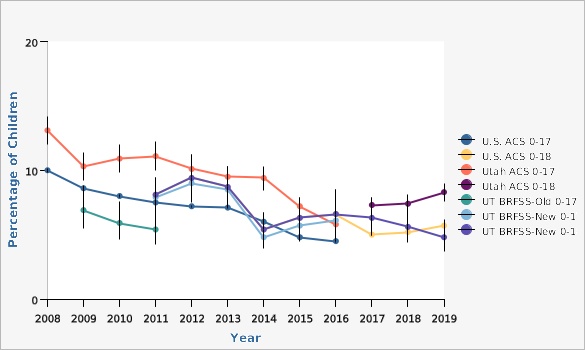
Compared with state surveys in Utah, the U.S. Current Population Survey (CPS) and the American Community Survey (ACS) have historically yielded higher estimates of the Utah population with no health insurance coverage. Reasons may include difference in question wording, data weighting, and data imputation for missing values. For a thorough discussion of why state health insurance estimates differ from those produced by the U.S. Census Bureau, please refer to the State Health Access Data Assistance Center (SHADAC) publication 'Comparing Federal Government Surveys that Count the Uninsured: 2016' at [http://www.shadac.org/publications/comparing-federal-government-surveys-count-uninsured-2016].
Beginning in 2017, the age categories in the ACS health insurance tables were updated so that the age group for children includes individuals age 18 and younger. In 2016 and previous years, the age group for children included individuals age 17 and younger.
Beginning in 2011, BRFSS data include both landline and cell phone telephone users as well as an updated weighting methodology for analysis. BRFSS data shown in this graph are based on the old methodology for years 2009 and 2010 and the new methodology for years 2011 forward.
| U.S. ACS 0-17 & 0-18, Utah ACS 0-17 & 0-18, Utah BRFSS 0-17 & 0-18 | Year | Percentage of Children | Lower Limit | Upper Limit | ||
|---|---|---|---|---|---|---|
Record Count: 48 | ||||||
| U.S. ACS 0-17 | 2008 | 10.0% | 9.8% | 10.1% | ||
| U.S. ACS 0-17 | 2009 | 8.6% | 8.5% | 8.7% | ||
| U.S. ACS 0-17 | 2010 | 8.0% | 7.9% | 8.1% | ||
| U.S. ACS 0-17 | 2011 | 7.5% | 7.4% | 7.6% | ||
| U.S. ACS 0-17 | 2012 | 7.2% | 7.1% | 7.3% | ||
| U.S. ACS 0-17 | 2013 | 7.1% | 7.0% | 7.2% | ||
| U.S. ACS 0-17 | 2014 | 6.0% | 5.9% | 6.1% | ||
| U.S. ACS 0-17 | 2015 | 4.8% | 4.7% | 4.9% | ||
| U.S. ACS 0-17 | 2016 | 4.5% | 4.4% | 4.6% | ||
| U.S. ACS 0-18 | 2011 | 8.1% | 7.0% | 9.4% | ||
| U.S. ACS 0-18 | 2012 | 9.4% | 7.9% | 11.2% | ||
| U.S. ACS 0-18 | 2013 | 8.7% | 7.3% | 10.3% | ||
| U.S. ACS 0-18 | 2014 | 5.4% | 4.4% | 6.7% | ||
| U.S. ACS 0-18 | 2015 | 6.3% | 5.0% | 7.9% | ||
| U.S. ACS 0-18 | 2016 | 6.6% | 5.0% | 8.5% | ||
| U.S. ACS 0-18 | 2017 | 5.0% | 4.9% | 5.1% | ||
| U.S. ACS 0-18 | 2018 | 5.2% | 5.1% | 5.3% | ||
| U.S. ACS 0-18 | 2019 | 5.7% | 5.6% | 5.8% | ||
| Utah ACS 0-17 | 2008 | 13.1% | 12.0% | 14.2% | ||
| Utah ACS 0-17 | 2009 | 10.3% | 9.2% | 11.4% | ||
| Utah ACS 0-17 | 2010 | 10.9% | 9.8% | 12.0% | ||
| Utah ACS 0-17 | 2011 | 11.1% | 10.0% | 12.2% | ||
| Utah ACS 0-17 | 2012 | 10.1% | 9.2% | 11.1% | ||
| Utah ACS 0-17 | 2013 | 9.5% | 8.7% | 10.3% | ||
| Utah ACS 0-17 | 2014 | 9.4% | 8.4% | 10.3% | ||
| Utah ACS 0-17 | 2015 | 7.2% | 6.6% | 7.8% | ||
| Utah ACS 0-17 | 2016 | 5.8% | 5.2% | 6.4% | ||
| Utah ACS 0-18 | 2017 | 7.3% | 6.7% | 7.9% | ||
| Utah ACS 0-18 | 2018 | 7.4% | 6.7% | 8.1% | ||
| Utah ACS 0-18 | 2019 | 8.3% | 7.6% | 9.0% | ||
| UT BRFSS-Old 0-17 | 2009 | 6.9% | 5.5% | 8.8% | ||
| UT BRFSS-Old 0-17 | 2010 | 5.9% | 4.6% | 7.6% | ||
| UT BRFSS-Old 0-17 | 2011 | 5.4% | 4.2% | 6.9% | ||
| UT BRFSS-New 0-17 | 2011 | 7.9% | 6.8% | 9.1% | ||
| UT BRFSS-New 0-17 | 2012 | 9.0% | 7.5% | 10.8% | ||
| UT BRFSS-New 0-17 | 2013 | 8.5% | 7.1% | 10.1% | ||
| UT BRFSS-New 0-17 | 2014 | 4.8% | 3.9% | 6.0% | ||
| UT BRFSS-New 0-17 | 2015 | 5.7% | 4.5% | 7.2% | ||
| UT BRFSS-New 0-17 | 2016 | 6.1% | 4.6% | 8.0% | ||
| UT BRFSS-New 0-18 | 2011 | 8.1% | 7.0% | 9.4% | ||
| UT BRFSS-New 0-18 | 2012 | 9.4% | 7.9% | 11.2% | ||
| UT BRFSS-New 0-18 | 2013 | 8.7% | 7.3% | 10.3% | ||
| UT BRFSS-New 0-18 | 2014 | 5.4% | 4.4% | 6.7% | ||
| UT BRFSS-New 0-18 | 2015 | 6.3% | 5.0% | 7.9% | ||
| UT BRFSS-New 0-18 | 2016 | 6.6% | 5.0% | 8.5% | ||
| UT BRFSS-New 0-18 | 2017 | 6.3% | 4.9% | 7.9% | ||
| UT BRFSS-New 0-18 | 2018 | 5.6% | 4.4% | 7.1% | ||
| UT BRFSS-New 0-18 | 2019 | 4.8% | 3.7% | 6.2% | ||
Data Notes
Health insurance is defined as including private coverage, Medicaid, Medicare, and other government programs. [[br]] [[br]] Estimates for this graph are crude, not age-adjusted.[[br]] [[br]] Beginning in 2017, the age categories in the ACS health insurance tables were updated so that the age group for children includes individuals age 18 and younger. In 2016 and previous years, the age group for children included individuals age 17 and younger.Data Sources
- American Community Survey
- Utah Data: Behavioral Risk Factor Surveillance System, Office of Public Health Assessment, Utah Department of Health
| Survey Methodology | Year | Crude Percentage of Persons | Lower Limit | Upper Limit | ||
|---|---|---|---|---|---|---|
Record Count: 22 | ||||||
| HSS-Old | 1986 | 13.5% | ||||
| HSS-Old | 1991 | 9.6% | 8.4% | 10.9% | ||
| HSS-Old | 1996 | 9.5% | 8.5% | 10.5% | ||
| HSS-Old | 2001 | 10.8% | ||||
| HSS-New | 2001 | 8.7% | 7.9% | 9.5% | ||
| HSS-New | 2003 | 9.1% | 7.9% | 10.3% | ||
| HSS-New | 2004 | 10.2% | 8.9% | 11.5% | ||
| HSS-New | 2005 | 11.6% | 10.1% | 13.2% | ||
| HSS-New | 2006 | 11.9% | 10.3% | 13.6% | ||
| HSS-New | 2007 | 10.6% | 9.1% | 12.4% | ||
| HSS-New | 2008 | 10.7% | 9.0% | 12.7% | ||
| BRFSS-Old | 2009 | 11.2% | 10.1% | 12.4% | ||
| BRFSS-Old | 2010 | 10.6% | 9.6% | 11.6% | ||
| BRFSS-New | 2011 | 13.4% | 12.5% | 14.4% | ||
| BRFSS-New | 2012 | 13.2% | 12.1% | 14.3% | ||
| BRFSS-New | 2013 | 11.6% | 10.5% | 12.7% | ||
| BRFSS-New | 2014 | 10.3% | 9.5% | 11.2% | ||
| BRFSS-New | 2015 | 8.8% | 7.9% | 9.9% | ||
| BRFSS-New | 2016 | 8.7% | 7.6% | 9.9% | ||
| BRFSS-New | 2017 | 9.8% | 8.8% | 10.9% | ||
| BRFSS-New | 2018 | 9.5% | 8.6% | 10.5% | ||
| BRFSS-New | 2019 | 8.6% | 7.7% | 9.6% | ||
Data Notes
Health insurance is defined as including private coverage, Medicaid, Medicare, and other government programs. [[br]] [[br]] Estimates for this graph are crude, not age-adjusted. [[br]] [[br]] In 2001, the method used by the the Utah Healthcare Access Survey (formerly called the Health Status Survey) was changed to include follow-up questions for persons who reported they were not covered by health insurance. The 2001 figures, above, are reported both using and not using the new follow-up questions. The new method suggests that the rate may be lower than we previously believed, but does not suggest a decrease from 1996 to 2001. [[br]] [[br]] Beginning in 2009, these data have been collected on the Behavioral Risk Factor Surveillance System (BRFSS) as the UHAS is no longer being conducted. [[br]] [[br]] In 2011, the BRFSS underwent some methodology changes: the addition of cell phone only households to the sampling frame and an updated weighting methodology.Data Sources
- Utah Data: Behavioral Risk Factor Surveillance System, Office of Public Health Assessment, Utah Department of Health
- Utah Healthcare Access Survey (formerly Utah Health Status Survey), Office of Public Health Assessment, Utah Department of Health
| Males vs. Females | Age Group | Percentage of Persons | Lower Limit | Upper Limit | Note | |
|---|---|---|---|---|---|---|
Record Count: 14 | ||||||
| Male | 6 to 18 | 13.3% | 6.2% | 26.2% | * | |
| Male | 19 to 26 | 20.7% | 17.4% | 24.4% | ||
| Male | 27 to 34 | 15.8% | 12.9% | 19.2% | ||
| Male | 35 to 49 | 15.2% | 12.9% | 17.9% | ||
| Male | 50 to 64 | 12.4% | 10.2% | 14.9% | ||
| Male | 65 and Over | 1.5% | 0.9% | 2.6% | ||
| Female | 6 to 18 | 15.2% | 8.4% | 26.0% | ||
| Female | 19 to 26 | 14.5% | 11.3% | 18.4% | ||
| Female | 27 to 34 | 17.0% | 13.8% | 20.8% | ||
| Female | 35 to 49 | 14.6% | 12.2% | 17.3% | ||
| Female | 50 to 64 | 10.8% | 8.7% | 13.3% | ||
| Female | 65 and Over | 1.1% | 0.7% | 1.8% | ||
Data Notes
Health insurance is defined as including private coverage, Medicaid, Medicare, and other government programs. [[br]] [[br]] *Use caution when interpreting. Estimates marked with this symbol in the data table have a coefficient of variation greater than 30% and less than or equal to 50% and are therefore deemed unreliable by Utah Department of Health standards.Data Source
Utah Data: Behavioral Risk Factor Surveillance System, Office of Public Health Assessment, Utah Department of Health| All Ages vs 19-64 | Local Health District | Crude Percentage of Persons | Lower Limit | Upper Limit | Note | |
|---|---|---|---|---|---|---|
Record Count: 26 | ||||||
| All Ages | Bear River | 10.5% | 7.6% | 14.4% | ||
| All Ages | Central | 14.4% | 10.7% | 19.0% | ||
| All Ages | Davis County | 11.3% | 8.9% | 14.2% | ||
| All Ages | Salt Lake County | 12.3% | 10.9% | 13.8% | ||
| All Ages | San Juan | 24.0% | 14.2% | 37.6% | ||
| All Ages | Southeast | 14.4% | 9.5% | 21.1% | ||
| All Ages | Southwest | 16.5% | 13.5% | 20.0% | ||
| All Ages | Summit | 10.4% | 6.5% | 16.2% | ||
| All Ages | Tooele | 9.5% | 6.1% | 14.3% | ||
| All Ages | TriCounty | 14.6% | 10.1% | 20.5% | ||
| All Ages | Utah County | 10.9% | 9.3% | 12.7% | ||
| All Ages | Wasatch | 16.6% | 11.0% | 24.3% | ||
| All Ages | Weber-Morgan | 11.4% | 8.8% | 14.7% | ||
| 19-64 | Bear River | 12.5% | 9.0% | 17.2% | ||
| 19-64 | Central | 18.2% | 13.5% | 24.3% | ||
| 19-64 | Davis County | 13.2% | 10.4% | 16.6% | ||
| 19-64 | Salt Lake County | 14.5% | 12.8% | 16.4% | ||
| 19-64 | San Juan | 29.0% | 16.9% | 45.0% | ||
| 19-64 | Southeast | 17.6% | 11.9% | 25.2% | * | |
| 19-64 | Southwest | 22.4% | 18.3% | 27.2% | ||
| 19-64 | Summit | 13.3% | 8.3% | 20.6% | ||
| 19-64 | Tooele | 11.2% | 7.2% | 17.1% | * | |
| 19-64 | TriCounty | 16.9% | 11.6% | 24.0% | * | |
| 19-64 | Utah County | 12.3% | 10.5% | 14.4% | ||
| 19-64 | Wasatch | 20.7% | 13.6% | 30.1% | ||
| 19-64 | Weber-Morgan | 14.0% | 10.8% | 17.9% | * | |
Data Notes
Health insurance is defined as including private coverage, Medicaid, Medicare, and other government programs. [[br]] [[br]] Data not age-adjusted. [[br]] [[br]] *Use caution in interpreting. The estimates have a relative standard error greater than 30% and are therefore deemed unreliable by Utah Department of Health standards. [[br]] [[br]] **The estimate has been suppressed because the relative standard error is greater than 50%.Data Source
Utah Data: Behavioral Risk Factor Surveillance System, Office of Public Health Assessment, Utah Department of Health| Local Health District | Age-adjusted Percentage of Persons | Lower Limit | Upper Limit | |||
|---|---|---|---|---|---|---|
Record Count: 14 | ||||||
| Bear River | 10.0% | 7.2% | 13.8% | |||
| Central | 15.1% | 11.4% | 19.6% | |||
| Davis County | 11.1% | 8.8% | 13.9% | |||
| Salt Lake County | 12.1% | 10.8% | 13.7% | |||
| San Juan | 28.6% | 18.2% | 42.0% | |||
| Southeast | 16.1% | 10.8% | 23.2% | |||
| Southwest | 18.7% | 15.3% | 22.6% | |||
| Summit | 11.1% | 6.9% | 17.6% | |||
| Tooele | 9.3% | 6.1% | 13.9% | |||
| TriCounty | 14.8% | 10.6% | 20.2% | |||
| Utah County | 10.3% | 8.8% | 12.0% | |||
| Wasatch | 19.5% | 13.2% | 27.9% | |||
| Weber-Morgan | 11.4% | 8.7% | 14.6% | |||
| State of Utah | 12.5% | 11.7% | 13.4% | |||
Data Notes
Health insurance is defined as including private coverage, Medicaid, Medicare, and other government programs. [[br]] [[br]] Age-adjusted to U.S. 2000 standard population using 6 age-adjustment age groups. [[br]] [[br]] *Use caution in interpreting. The estimates have a relative standard error >30% and are therefore deemed unreliable by Utah Department of Health standards.Data Source
Utah Data: Behavioral Risk Factor Surveillance System, Office of Public Health Assessment, Utah Department of Health| Utah Small Areas | Age-adjusted Percentage of Persons | Lower Limit | Upper Limit | Note | ||
|---|---|---|---|---|---|---|
Record Count: 100 | ||||||
| Brigham City | 10.4% | 7.1% | 15.0% | |||
| Box Elder Co (Other) V2 | 14.2% | 9.0% | 21.5% | |||
| Tremonton | 12.0% | 7.6% | 18.4% | |||
| Logan V2 | 11.9% | 9.3% | 15.0% | |||
| North Logan | 8.2% | 5.0% | 13.4% | |||
| Cache (Other)/Rich (All) V2 | 10.2% | 7.2% | 14.3% | |||
| Hyrum | 12.4% | 7.0% | 21.1% | * | ||
| Smithfield | 6.6% | 3.3% | 12.8% | * | ||
| Ben Lomond | 15.6% | 12.7% | 19.1% | |||
| Weber County (East) | 3.5% | 2.0% | 6.0% | |||
| Morgan County | 5.8% | 3.1% | 10.4% | * | ||
| Ogden (Downtown) | 12.3% | 9.5% | 15.9% | |||
| South Ogden | 14.6% | 11.4% | 18.6% | |||
| Roy/Hooper | 9.4% | 6.9% | 12.7% | |||
| Riverdale | 10.0% | 7.1% | 13.9% | |||
| Clearfield Area/Hooper | 10.3% | 8.2% | 12.9% | |||
| Layton/South Weber | 8.9% | 7.0% | 11.2% | |||
| Kaysville/Fruit Heights | 6.6% | 4.1% | 10.4% | |||
| Syracuse | 6.7% | 3.9% | 11.1% | |||
| Centerville | 6.2% | 3.3% | 11.4% | * | ||
| Farmington | 2.4% | 1.0% | 5.4% | * | ||
| North Salt Lake | 9.0% | 5.5% | 14.4% | |||
| Woods Cross/West Bountiful | 7.5% | 4.0% | 13.7% | * | ||
| Bountiful | 9.6% | 7.0% | 13.0% | |||
| SLC (Rose Park) | 22.5% | 18.1% | 27.5% | |||
| SLC (Avenues) | 8.9% | 5.7% | 13.6% | |||
| SLC (Foothill/East Bench) | 3.8% | 2.0% | 7.2% | * | ||
| Magna | 14.8% | 10.7% | 20.1% | |||
| SLC (Glendale) V2 | 23.5% | 17.8% | 30.4% | |||
| West Valley (Center) | 20.8% | 17.2% | 25.0% | |||
| West Valley (West) V2 | 9.9% | 6.9% | 14.1% | |||
| West Valley (East) V2 | 26.3% | 22.0% | 31.1% | |||
| SLC (Downtown) V2 | 14.9% | 11.2% | 19.4% | |||
| SLC (Southeast Liberty) | 8.5% | 5.5% | 12.9% | |||
| South Salt Lake | 19.3% | 14.6% | 25.2% | |||
| SLC (Sugar House) | 9.8% | 7.1% | 13.3% | |||
| Millcreek (South) | 6.1% | 3.1% | 11.9% | * | ||
| Millcreek (East) | 4.1% | 2.3% | 7.2% | |||
| Holladay V2 | 11.0% | 7.4% | 16.1% | |||
| Cottonwood | 8.9% | 6.1% | 12.9% | |||
| Kearns V2 | 17.9% | 14.0% | 22.6% | |||
| Taylorsville (E)/Murray (W) | 12.9% | 9.8% | 16.9% | |||
| Taylorsville (West) | 11.2% | 8.0% | 15.4% | |||
| Murray | 11.2% | 7.9% | 15.7% | |||
| Midvale | 17.1% | 13.0% | 22.1% | |||
| West Jordan (Northeast) V2 | 10.8% | 7.6% | 15.2% | |||
| West Jordan (Southeast) | 9.6% | 6.6% | 13.6% | |||
| West Jordan (W)/Copperton | 9.9% | 7.2% | 13.3% | |||
| South Jordan V2 | 6.5% | 4.4% | 9.5% | |||
| Daybreak | 6.4% | 3.8% | 10.6% | * | ||
| Sandy (West) | 13.4% | 10.0% | 17.8% | |||
| Sandy (Center) V2 | 6.3% | 4.0% | 9.7% | * | ||
| Sandy (Northeast) | 6.8% | 3.8% | 12.0% | ** | ||
| Sandy (Southeast) | 7.0% | 4.1% | 11.7% | * | ||
| Draper | 6.5% | 4.0% | 10.2% | * | ||
| Riverton/Bluffdale | 7.3% | 5.0% | 10.6% | * | ||
| Herriman | 6.7% | 4.5% | 10.0% | * | ||
| Tooele County (Other) | 15.3% | 11.1% | 20.7% | |||
| Tooele Valley | 8.4% | 6.6% | 10.5% | |||
| Eagle Mountain/Cedar Valley | 9.6% | 6.7% | 13.7% | |||
| Lehi | 5.4% | 3.9% | 7.4% | |||
| Saratoga Springs | 5.0% | 2.8% | 8.7% | |||
| American Fork | 6.7% | 4.6% | 9.6% | |||
| Alpine | 5.1% | 2.4% | 10.5% | * | ||
| Pleasant Grove/Lindon | 8.9% | 6.7% | 11.7% | |||
| Orem (North) | 13.3% | 10.3% | 17.0% | |||
| Orem (West) | 16.2% | 12.6% | 20.7% | |||
| Orem (East) | 11.8% | 7.8% | 17.4% | |||
| Provo/BYU | 9.8% | 6.9% | 13.6% | |||
| Provo (West City Center) | 21.2% | 16.5% | 26.8% | |||
| Provo (East City Center) | 8.0% | 4.5% | 13.9% | |||
| Salem City | 9.2% | 5.2% | 15.5% | * | ||
| Spanish Fork | 9.6% | 7.1% | 12.9% | |||
| Springville | 13.4% | 10.0% | 17.8% | |||
| Mapleton | 4.0% | 1.8% | 8.6% | * | ||
| Utah County (South) V2 | 12.0% | 7.8% | 18.2% | |||
| Payson | 8.6% | 5.8% | 12.5% | |||
| Park City | 16.4% | 12.5% | 21.1% | |||
| Summit County (East) | 11.5% | 8.2% | 15.9% | |||
| Wasatch County | 13.7% | 10.8% | 17.1% | |||
| Daggett and Uintah County | 12.5% | 10.4% | 14.8% | |||
| Duchesne County | 13.9% | 11.0% | 17.5% | |||
| Nephi/Mona | 12.4% | 8.0% | 18.6% | |||
| Delta/Fillmore | 20.7% | 14.6% | 28.3% | |||
| Sanpete Valley | 12.2% | 9.2% | 16.0% | |||
| Central (Other) | 14.9% | 11.7% | 18.7% | |||
| Richfield/Monroe/Salina | 12.7% | 9.3% | 17.2% | |||
| Carbon County | 9.6% | 7.3% | 12.7% | |||
| Emery County | 12.3% | 8.4% | 17.6% | |||
| Grand County | 25.0% | 18.5% | 32.8% | |||
| Blanding/Monticello | 15.1% | 10.8% | 20.6% | |||
| San Juan County (Other) | 23.1% | 15.6% | 32.9% | |||
| St. George | 15.5% | 13.1% | 18.3% | |||
| Washington Co (Other) V2 | 27.7% | 21.4% | 35.1% | |||
| Washington City | 15.1% | 10.9% | 20.6% | |||
| Hurricane/La Verkin | 17.3% | 12.7% | 23.3% | |||
| Ivins/Santa Clara | 10.2% | 5.3% | 17.7% | * | ||
| Cedar City | 15.3% | 12.1% | 19.2% | |||
| Southwest LHD (Other) | 24.7% | 19.5% | 30.8% | |||
| State of Utah | 12.0% | 11.6% | 12.4% | |||
Data Notes
Health insurance is defined as including private coverage, Medicaid, Medicare, and other government programs. [[br]] [[br]] Age-adjusted to U.S. 2000 standard population using 6 age-adjustment age groups. These estimates are for Utahns of ALL AGES. [[br]] [[br]] *Use caution when interpreting. Estimates marked with this symbol have a coefficient of variation greater than 30% and are therefore deemed unreliable by Utah Department of Health standards. [[br]] [[br]] **Value has been suppressed because the sample size was too small to produce a reliable estimate. [[br]] [[br]] A description of the Utah Small Areas may be found on IBIS at the following URL: [https://ibis.health.utah.gov/resource/Guidelines.html].Data Source
Utah Data: Behavioral Risk Factor Surveillance System, Office of Public Health Assessment, Utah Department of Health| Race | Age-adjusted Percentage of Persons | Lower Limit | Upper Limit | Note | ||
|---|---|---|---|---|---|---|
Record Count: 5 | ||||||
| American Indian/Native Alaskan | 18.5% | 12.7% | 26.1% | |||
| Asian | 8.1% | 3.9% | 16.0% | * | ||
| Black | 32.3% | 22.2% | 44.4% | |||
| Pacific Islander | 17.6% | 8.9% | 31.8% | * | ||
| White | 9.7% | 9.0% | 10.5% | |||
Data Notes
Health insurance is defined as including private coverage, Medicaid, Medicare, and other government programs. [[br]] [[br]] Age-adjusted to the U.S. 2000 standard population using 6 age-adjustment age groups. [[br]] [[br]] *Use caution when interpreting. Estimates marked with this symbol in the data table have a coefficient of variation greater than 30% and less than or equal to 50% and are therefore deemed unreliable by Utah Department of Health standards.Data Source
Utah Data: Behavioral Risk Factor Surveillance System, Office of Public Health Assessment, Utah Department of Health| Hispanic Ethnicity | Age-adjusted Percentage of Persons | Lower Limit | Upper Limit | |||
|---|---|---|---|---|---|---|
Record Count: 2 | ||||||
| Hispanic | 35.1% | 31.8% | 38.6% | |||
| Non-Hispanic | 8.5% | 7.8% | 9.3% | |||
Data Notes
Health insurance is defined as including private coverage, Medicaid, Medicare, and other government programs. [[br]] [[br]] Age-adjusted to the U.S. 2000 standard population using 6 age-adjustment age groups.Data Source
Utah Data: Behavioral Risk Factor Surveillance System, Office of Public Health Assessment, Utah Department of Health| Employment Status | Crude Percentage of Persons Aged 19-64 | Lower Limit | Upper Limit | Note | ||
|---|---|---|---|---|---|---|
Record Count: 8 | ||||||
| Employed | 11.9% | 10.8% | 13.1% | |||
| Self-employed | 24.3% | 20.7% | 28.3% | |||
| Out of Work >1 Yr | 39.7% | 28.9% | 51.6% | |||
| Out of Work <1 Yr | 34.2% | 26.4% | 42.9% | |||
| Homemaker | 20.1% | 16.5% | 24.3% | |||
| Student | 11.5% | 7.6% | 17.1% | * | ||
| Retired | 8.1% | 4.6% | 13.9% | ** | ||
| Unable to Work | 12.9% | 8.8% | 18.6% | |||
Data Notes
Health insurance is defined as including private coverage, Medicaid, Medicare, and other government programs. [[br]] [[br]] Data not age-adjusted. [[br]] [[br]]*Use caution when interpreting. Estimates marked with this symbol in the data table have a coefficient of variation greater than 30% and less than or equal to 50% and are therefore deemed unreliable by Utah Department of Health standards. [[br]] [[br]]**Value has been suppressed because the sample size was too small to produce a reliable estimate.Data Source
Utah Data: Behavioral Risk Factor Surveillance System, Office of Public Health Assessment, Utah Department of Health| Income Category | Age-adjusted Percentage of Persons | Lower Limit | Upper Limit | |||
|---|---|---|---|---|---|---|
Record Count: 4 | ||||||
| <$25,000 | 29.3% | 26.1% | 32.8% | |||
| $25,000-$49,999 | 19.7% | 17.3% | 22.4% | |||
| $50,000-$74,999 | 8.3% | 6.8% | 10.2% | |||
| $75,000+ | 4.3% | 3.5% | 5.3% | |||
Data Notes
Health insurance is defined as including private coverage, Medicaid, Medicare, and other government programs. [[br]] [[br]] Age-adjusted to the U.S. 2000 standard population using 6 age-adjustment age groups.Data Source
Utah Data: Behavioral Risk Factor Surveillance System, Office of Public Health Assessment, Utah Department of HealthNo Health Insurance Coverage, Utah and U.S. UHAS and CPS Estimates, 1988-2008
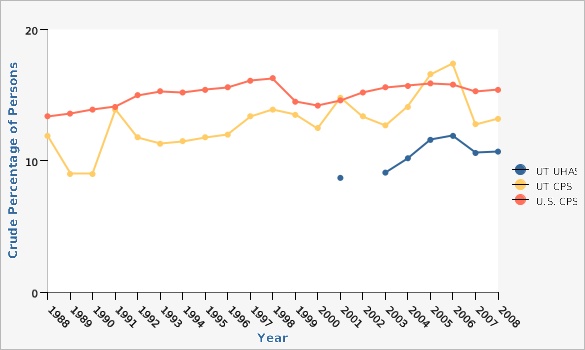
| Utah BRFSS, Utah UHAS, Utah CPS, U.S. CPS | Year | Crude Percentage of Persons | ||||
|---|---|---|---|---|---|---|
Record Count: 49 | ||||||
| UT UHAS | 2001 | 8.7% | ||||
| UT UHAS | 2003 | 9.1% | ||||
| UT UHAS | 2004 | 10.2% | ||||
| UT UHAS | 2005 | 11.6% | ||||
| UT UHAS | 2006 | 11.9% | ||||
| UT UHAS | 2007 | 10.6% | ||||
| UT UHAS | 2008 | 10.7% | ||||
| UT CPS | 1988 | 11.9% | ||||
| UT CPS | 1989 | 9.0% | ||||
| UT CPS | 1990 | 9.0% | ||||
| UT CPS | 1991 | 13.9% | ||||
| UT CPS | 1992 | 11.8% | ||||
| UT CPS | 1993 | 11.3% | ||||
| UT CPS | 1994 | 11.5% | ||||
| UT CPS | 1995 | 11.8% | ||||
| UT CPS | 1996 | 12.0% | ||||
| UT CPS | 1997 | 13.4% | ||||
| UT CPS | 1998 | 13.9% | ||||
| UT CPS | 1999 | 13.5% | ||||
| UT CPS | 2000 | 12.5% | ||||
| UT CPS | 2001 | 14.8% | ||||
| UT CPS | 2002 | 13.4% | ||||
| UT CPS | 2003 | 12.7% | ||||
| UT CPS | 2004 | 14.1% | ||||
| UT CPS | 2005 | 16.6% | ||||
| UT CPS | 2006 | 17.4% | ||||
| UT CPS | 2007 | 12.8% | ||||
| UT CPS | 2008 | 13.2% | ||||
| U.S. CPS | 1988 | 13.4% | ||||
| U.S. CPS | 1989 | 13.6% | ||||
| U.S. CPS | 1990 | 13.9% | ||||
| U.S. CPS | 1991 | 14.1% | ||||
| U.S. CPS | 1992 | 15.0% | ||||
| U.S. CPS | 1993 | 15.3% | ||||
| U.S. CPS | 1994 | 15.2% | ||||
| U.S. CPS | 1995 | 15.4% | ||||
| U.S. CPS | 1996 | 15.6% | ||||
| U.S. CPS | 1997 | 16.1% | ||||
| U.S. CPS | 1998 | 16.3% | ||||
| U.S. CPS | 1999 | 14.5% | ||||
| U.S. CPS | 2000 | 14.2% | ||||
| U.S. CPS | 2001 | 14.6% | ||||
| U.S. CPS | 2002 | 15.2% | ||||
| U.S. CPS | 2003 | 15.6% | ||||
| U.S. CPS | 2004 | 15.7% | ||||
| U.S. CPS | 2005 | 15.9% | ||||
| U.S. CPS | 2006 | 15.8% | ||||
| U.S. CPS | 2007 | 15.3% | ||||
| U.S. CPS | 2008 | 15.4% | ||||
Data Notes
Health insurance is defined as including private coverage, Medicaid, Medicare, and other government programs. [[br]] Estimates for this graph are crude, not age-adjusted. This graphical view is being kept for historical purposes. For a thorough discussion of why state health insurance estimates differ from those produced by the U.S. Current Population Survey (CPS), please refer to the State Health Access Data Assistance Center (SHADAC) publication 'Comparing Federal Government Surveys that Count the Uninsured: 2014' at [http://www.shadac.org/publications/comparing-federal-government-surveys-count-uninsured-2014]. The Census Bureau suggests using 2-year averages to look at changes in state rates over time, according to the CPS 2009 Annual Social and Economic Supplement technical notes, Appendix G, available at [http://www.census.gov/prod/techdoc/cps/cpsmar09.pdf]. For the historical CPS graph, we use the CPS single-year estimates to compare with the UHAS one-year estimates. Though CPS does not suppress Utah's single-year estimates, they should be interpreted with some caution.Data Sources
- Utah Healthcare Access Survey (formerly Utah Health Status Survey), Office of Public Health Assessment, Utah Department of Health
- U.S. Current Population Survey
No Health Insurance Coverage, Utah and U.S. UHAS, and CPS Estimates, Children 0-17, 1988-2008

Data Notes
Health insurance is defined as including private coverage, Medicaid, Medicare, and other government programs. [[br]][[br]] Estimates for this graph are crude, not age-adjusted. This graphical view is being kept for historical purposes. For a thorough discussion of why state health insurance estimates differ from those produced by the U.S. Current Population Survey (CPS), please refer to the State Health Access Data Assistance Center (SHADAC) publication 'Comparing Federal Government Surveys that Count the Uninsured: 2014' at [http://www.shadac.org/publications/comparing-federal-government-surveys-count-uninsured-2014]. The Census Bureau suggests using 2-year averages to look at changes in state rates over time, according to the CPS 2009 Annual Social and Economic Supplement technical notes, Appendix G, available at [http://www.census.gov/prod/techdoc/cps/cpsmar09.pdf]. For the historical CPS graph, we use the CPS single-year estimates to compare with the UHAS one-year estimates. Though CPS does not suppress Utah's single-year estimates, they should be interpreted with some caution.Data Sources
- Utah Healthcare Access Survey (formerly Utah Health Status Survey), Office of Public Health Assessment, Utah Department of Health
- U.S. Current Population Survey
More Resources and Links
Evidence-based community health improvement ideas and interventions may be found at the following sites:- Centers for Disease Control and Prevention (CDC) WONDER Database, a system for disseminating public health data and information.
- United States Census Bureau data dashboard.
- Utah healthy Places Index, evidence-based and peer-reviewed tool, supports efforts to prioritize equitable community investments, develop critical programs and policies across the state, and much more.
- County Health Rankings
- Kaiser Family Foundation's StateHealthFacts.org
- Medical literature can be queried at PubMed library.
Page Content Updated On 10/22/2021,
Published on 01/13/2022


